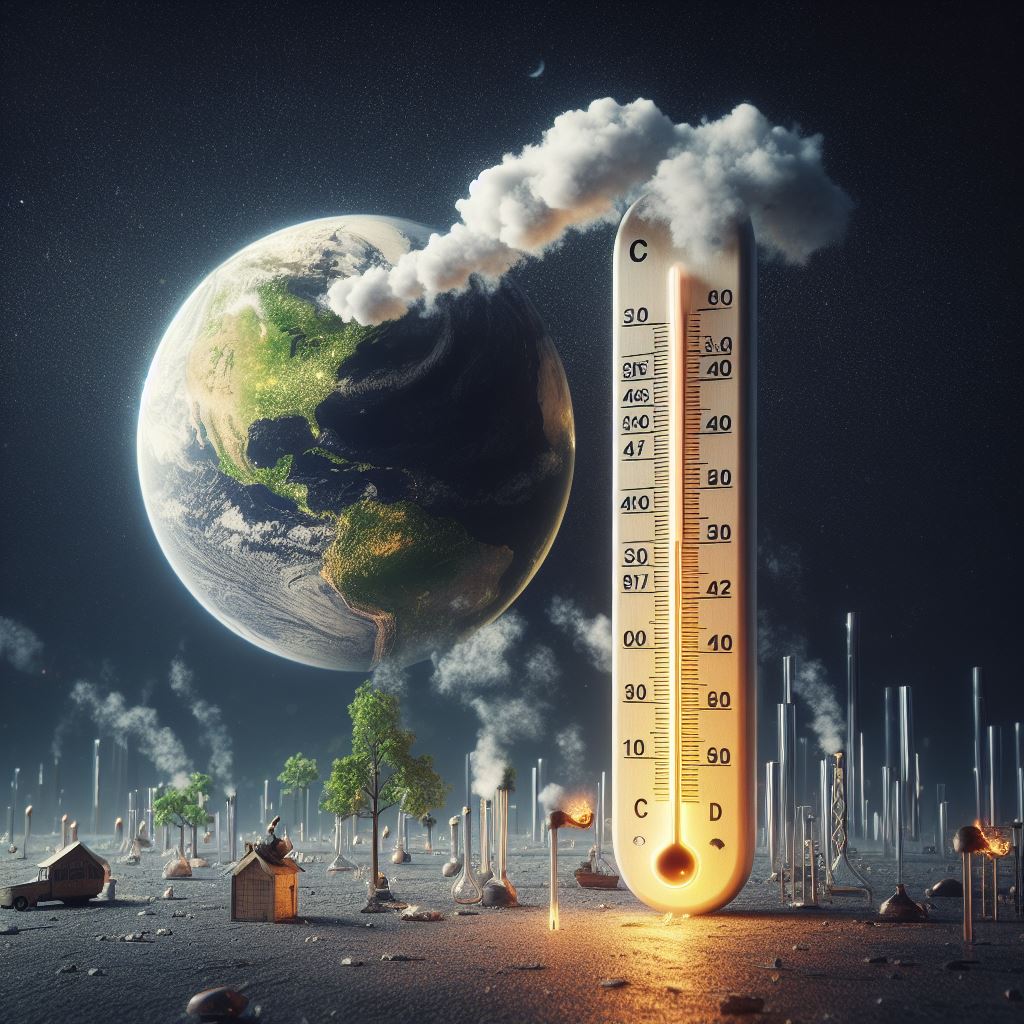
Greenhouse gases are like a blanket for our planet. They trap heat from the sun and keep Earth warm enough for us to live. But, too many of these gases can lead to problems like climate change. This blog will discuss these gases, their origin, and how they change our planet.
Think of greenhouse gases as the invisible forces that help control our climate. The most common ones are carbon dioxide, methane, and nitrous oxide. They come from everyday things like cars, factories, and even cows! But they also come from natural places like wetlands and volcanoes.
You might wonder why we’re talking about this. Knowing how these gases affect our weather, health, and future is essential. By understanding them, we can make better choices to protect our planet. If you’re a student finding this topic challenging, remember that a tutor can help break down these concepts into simpler terms.
What Are Greenhouse Gases?
Greenhouse gases are more than just components of our atmosphere; they play a critical role in shaping our climate and environment. This section will explore these gases, identify some vital types like carbon dioxide and methane, and look at where they come from.
Don’t worry, you’re not the only one struggling with greenhouse gases. It’s a complicated area requiring much understanding and theoretical knowledge. A private chemistry tutor can assist you. You can also turn to a private teacher who offers individual lessons in chemistry or biochemistry.
Read more topics and expand your chemistry horizons! Our World of Chemistry offers a plethora of free educational blogs.
Definition and Explanation of Greenhouse Gases
Greenhouse gases are a group of compounds that can trap heat in the Earth’s atmosphere, leading to the greenhouse effect. This effect is crucial for life on Earth, as it maintains the planet’s temperature comfortably. However, an excess of these gases can cause the Earth to heat up more than usual, leading to climate change. Greenhouse gases are unique in their ability to absorb and emit infrared radiation, contributing to the planet’s surface warming.
Examples of Common Greenhouse Gases
The most well-known greenhouse gases include carbon dioxide (CO2), methane (CH4), and nitrous oxide (N2O). Carbon dioxide is the primary greenhouse gas released by burning fossil fuels, deforestation, and various industrial processes. Methane, another potent greenhouse gas, is emitted while producing and transporting coal, oil, and natural gas. It’s also released by livestock and other agricultural practices. Nitrous oxide, while less abundant, is a significant contributor to the greenhouse effect and is mainly emitted from agricultural and industrial activities, as well as the combustion of fossil fuels and solid waste.
Natural vs. Anthropogenic: Sources of These Gases in the Environment
The sources of greenhouse gases are both natural and human-made. Natural sources include decomposition, ocean release, and respiration. However, human activities have significantly increased the concentrations of these gases in the atmosphere. The burning of fossil fuels for electricity, heat, and transportation is the largest human source of CO2 emissions. Industrial processes, waste management, and agriculture contribute significantly to methane and nitrous oxide emissions. Understanding these sources is crucial for developing strategies to reduce emissions and mitigate the impacts of climate change.
The basics of organic and inorganic chemistry.
Greenhouse Gases: Natural vs. Anthropogenic Sources
In the world of greenhouse gases, it’s crucial to distinguish between what nature creates and what results from human actions. This distinction helps us understand our impact on the environment and guides us in finding solutions to reduce emissions. Below, we compare natural and anthropogenic sources of greenhouse gases, shedding light on how both contribute to the overall levels of our atmosphere.
Greenhouse Gases: A Comparison of Natural and Human-Made Sources
The following table breaks down major greenhouse gases into their natural and human-made sources. This comparison gives us a clearer picture of how different activities contribute to greenhouse gas emissions.
|
Greenhouse Gas |
Natural Sources |
Anthropogenic Sources |
|
Carbon Dioxide (CO2) |
Respiration, decomposition, ocean release |
Burning of fossil fuels, deforestation, industrial processes |
|
Methane (CH4) |
Wetlands, termites, ocean |
Oil and gas production, livestock farming, landfills |
|
Nitrous Oxide (N2O) |
Soil and ocean processes |
Agricultural activities, industrial processes, combustion of fossil fuels |
Greenhouse Gases: Examining Natural and Human-Made Source Examples
Now, let’s dive deeper into specific examples of these sources. Understanding these examples helps us grasp the scope of greenhouse gas emissions and the role different sources play.
Natural Sources of Greenhouse Gas Emissions
- Carbon Dioxide: Plants and animals release CO2 during respiration. The decomposition of organic matter also contributes to CO2 levels.
- Methane: Wetlands and termites naturally emit methane as part of biological processes.
- Nitrous Oxide: Bacteria in soils and oceans produce nitrous oxide, especially in nitrogen-rich environments.
Human-Made Sources of Greenhouse Gas Emissions
- Carbon Dioxide: The burning of coal, oil, and natural gas for energy and transportation is a major source. Deforestation also contributes significantly.
- Methane: Human activities like fossil fuel production and agriculture, particularly livestock farming, are major sources.
- Nitrous Oxide: Agricultural practices, including fertilizers and industrial combustion processes, are significant contributors.
Learn about chromatography and solutions and mixtures.
How Greenhouse Gases Affect the Climate
Climate change is a hot topic, and greenhouse gases are right at its core. In this crucial section, you’ll discover the science behind the greenhouse effect and see how these gases alter our climate. Whether studying for a class, looking for tutoring assistance, or just curious about environmental science, understanding this concept is crucial in grasping the bigger picture of global warming.
The Greenhouse Effect: Earth’s Thermal Blanket
Greenhouse gases work like a thermal blanket around Earth. They trap heat from the sun, which is vital for keeping our planet warm enough for life. This process, known as the greenhouse effect, is natural and necessary. But, adding extra gases through activities like burning fossil fuels or deforestation is like adding extra layers to our blanket. This causes more heat to be trapped, leading to a rise in Earth’s temperature.
Global Warming: The Heat is On
Due to increased greenhouse gases, Earth is experiencing global warming; a steady rise in average temperatures. This isn’t just about warmer days; it’s about disrupting the balance that supports diverse life on Earth. If you find these concepts challenging, remember that a private tutor can help make sense of these complex issues with personalized lessons and classes.
Climate Change: A Chain Reaction
Global warming sets off a chain reaction, leading to climate change. This means long-term changes in typical weather patterns. We’re discussing more extreme weather events: harsher storms, severe droughts, and unpredictable seasons. These aren’t just statistics; they’re changes that affect ecosystems, water supply and even our food. Understanding this chain reaction is essential, especially if you’re a student diving into environmental science. Seeking tutoring or private classes can provide deeper insights into these critical issues.
All you need to know about vitamins and minerals.
The Science Behind the Greenhouse Effect
Greenhouse gases, such as carbon dioxide, methane, and nitrous oxide, act as Earth’s natural temperature regulators. They play a pivotal role in maintaining our planet’s energy balance. Here’s the science behind it: solar radiation from the sun reaches Earth, warming its surface. Usually, this heat would radiate back into space, but these gases trap a portion of it in the atmosphere.
This mechanism is similar to a greenhouse where plants are kept warm. Sunlight enters, warms the space, and is then retained inside to maintain a comfortable temperature. Likewise, greenhouse gases keep our planet’s surface warm by holding onto solar radiation.
This heat-trapping process is crucial for keeping Earth at a life-sustaining temperature. However, increasing these gases from human activities intensifies this natural effect, trapping more heat than usual. This enhanced greenhouse effect drives global warming, increasing Earth’s average surface temperature.
Measuring the Impact of Greenhouse Gases
To understand greenhouse gases, we must examine how we measure their impact. This isn’t just about numbers and data; it’s about understanding our planet’s health. In this section, we’ll explore the methods used to measure greenhouse gas concentrations and discuss the global trends in their emissions.
Tracking Greenhouse Gases: Precision in Measurement
Measuring greenhouse gas concentrations is a complex but vital task. Scientists use a variety of methods to track these gases accurately. Ground-based stations worldwide continuously monitor the air, analyzing the concentrations of gases like carbon dioxide and methane. Satellites also play a crucial role, providing comprehensive data on global greenhouse gas levels. These measurements are supplemented by air samples collected from airplanes and balloons. Advanced techniques like spectroscopy allow scientists to measure specific gases precisely, even at very low concentrations.
Global Emissions Trends: A Climate Snapshot
The global trends in greenhouse gas emissions tell a critical story about our planet’s changing climate. Over the past few decades, there has been a significant increase in the levels of greenhouse gases, particularly carbon dioxide. This rise is primarily attributed to human activities, such as the burning of fossil fuels and deforestation. The industrial and agricultural sectors also contribute significantly to methane and nitrous oxide emissions.
The basics of Polymers and PET plastic.
The Role of Carbon Footprint
Understanding your carbon footprint is like getting a personal report card on your environmental impact. It’s about seeing how your everyday actions contribute to greenhouse gas emissions. In this brief section, let’s break down what a carbon footprint is and why it matters.
Decoding the Carbon Footprint: Your Environmental Impact
A carbon footprint is the total amount of greenhouse gases, primarily carbon dioxide, emitted directly or indirectly by an individual, organization, event, or product. It encompasses everything from the electricity you use in your home to the fuel burned by the vehicles you travel in.
Interesting Aspects of Carbon Footprints:
- Daily Activities: Everything from your morning shower to your nightly TV time has a carbon footprint.
- Travel Habits: The mode of transportation and distance traveled significantly impact your carbon footprint.
- Food Choices: Meat-heavy diets generally have a higher carbon footprint than plant-based diets.
- Energy Consumption: The type of energy you use (renewable vs. non-renewable) dramatically influences your carbon footprint.
- Waste Management: How you dispose of waste and recycling practices also play a role in determining your carbon footprint.
Need help with biology topics? Explore our extensive collection of biology educational blog posts designed to simplify complex concepts for you. Whether it’s photosynthesis, osmosis, the intricacies of green algae, understanding bacteria and viruses, or delving into the fascinating world of genetics and cells, our resources have got you covered. Expand your knowledge and enhance your learning journey with us today.
Your Role in Tackling Greenhouse Gases and Climate Change
As we wrap up this discussion on greenhouse gases, it’s clear that this isn’t just a topic for textbooks or scientists. It’s about you and the world you live in. Understanding the intricacies of greenhouse gases – from their impact on our climate to your carbon footprint – is crucial for making informed choices that shape a healthier planet.
Remember, you’re not alone if these concepts seem overwhelming. There’s always room to learn more, and help is available. Whether through a tutor, engaging classes, or hands-on lessons, a private teacher can make these complex topics more accessible and relevant to your life.
Are you looking for a chemistry tutor? Enter “chemistry tutor Glasgow” or “chemistry teacher Sheffield” on your preferred tutoring platform, such as meet’n’learn, to find a teacher who can meet your specific needs.
If you thrive in group learning environments, search “chemistry classes London” or “chemistry lessons Manchester” online to discover local schools offering chemistry lessons.
Frequently Asked Questions About Greenhouse Gases
1. What Are Greenhouse Gases?
Greenhouse gases are compounds in the Earth’s atmosphere capable of trapping heat, thereby contributing to the warming of our planet. Key examples include carbon dioxide, methane, and nitrous oxide.
2. How Do Greenhouse Gases Cause Global Warming?
These gases trap solar energy in the atmosphere, preventing heat from escaping into space. This process, known as the greenhouse effect, increases Earth’s average temperature, contributing to global warming.
3. What Human Activities Increase Greenhouse Gas Emissions?
Human activities contributing to increased emissions include burning fossil fuels (like coal, oil, and natural gas), deforestation, industrial processes, and certain agricultural practices.
4. What Is the Difference Between Natural and Anthropogenic Greenhouse Gases?
Natural greenhouse gases come from wetlands, volcanoes, and the ocean. Anthropogenic, or human-made, greenhouse gases primarily result from industrial activities, burning fossil fuels, and agricultural practices.
5. How Are Greenhouse Gas Concentrations Measured?
Scientists use various methods, including ground-based stations, satellites, and air samples collected from airplanes and balloons, to accurately measure the concentrations of these gases in the atmosphere.
6. How Can I Learn More About Greenhouse Gases and Climate Change?
Consider enrolling in environmental science courses, attending workshops, or seeking help from a tutor or private teacher.
Are you interested in other subjects? Read top free study guides for Biology, English, French, and Music.
References:
1. EIA
2. Britannica
3. Wikipedia



